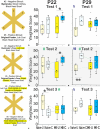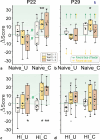Development of a New Scoring System in Higher Animals for Testing Cognitive Function in the Newborn Period: Effect of Prenatal Hypoxia-Ischemia
- PMID: 38547848
- PMCID: PMC11436483
- DOI: 10.1159/000538607
Development of a New Scoring System in Higher Animals for Testing Cognitive Function in the Newborn Period: Effect of Prenatal Hypoxia-Ischemia
Abstract
Introduction: Enhanced models for assessing cognitive function in the neonatal period are imperative in higher animals. Postnatal motor deficits, characteristic of cerebral palsy, emerge in newborn kits within our prenatal rabbit model of hypoxia-ischemia (HI). In humans, prenatal HI leads to intellectual disability and cerebral palsy. In a study examining cognitive function in newborn rabbits, we explored several questions. Is there a distinction between conditioned and unconditioned kits? Can the kits discern the human face or the laboratory coat? Do motorically normal kits, born after prenatal HI, exhibit cognitive deficits?
Methods: The conditioning protocol was randomly assigned to kits from each litter. For conditioning, the same human, wearing a laboratory coat, fed the rabbit kits for 9 days before the cognitive test. The 6-arm radial maze was chosen for its simplicity and ease of use. Normally appearing kits, born after uterine ischemia at 79% or 92% term in New Zealand White rabbits, were compared to naïve kits. On postpartum day 22/23 or 29/30, the 6-arm maze helped determine if the kits recognized the original feeder from bystander (test 1) or the laboratory coat on bystander (test 2). The use of masks of feeder/bystander (test 3) assessed confounding cues. A weighted score was devised to address variability in entry to maze arms, time, and repeated-trial learning.
Results: In conditioned kits, both naïve and HI kits exhibited a significant preference for the face of the feeder but not the laboratory coat. Cognitive deficits were minimal in normal-appearing HI kits.
Conclusion: The weighted score was amenable to statistical manipulation.
Introduction: Enhanced models for assessing cognitive function in the neonatal period are imperative in higher animals. Postnatal motor deficits, characteristic of cerebral palsy, emerge in newborn kits within our prenatal rabbit model of hypoxia-ischemia (HI). In humans, prenatal HI leads to intellectual disability and cerebral palsy. In a study examining cognitive function in newborn rabbits, we explored several questions. Is there a distinction between conditioned and unconditioned kits? Can the kits discern the human face or the laboratory coat? Do motorically normal kits, born after prenatal HI, exhibit cognitive deficits?
Methods: The conditioning protocol was randomly assigned to kits from each litter. For conditioning, the same human, wearing a laboratory coat, fed the rabbit kits for 9 days before the cognitive test. The 6-arm radial maze was chosen for its simplicity and ease of use. Normally appearing kits, born after uterine ischemia at 79% or 92% term in New Zealand White rabbits, were compared to naïve kits. On postpartum day 22/23 or 29/30, the 6-arm maze helped determine if the kits recognized the original feeder from bystander (test 1) or the laboratory coat on bystander (test 2). The use of masks of feeder/bystander (test 3) assessed confounding cues. A weighted score was devised to address variability in entry to maze arms, time, and repeated-trial learning.
Results: In conditioned kits, both naïve and HI kits exhibited a significant preference for the face of the feeder but not the laboratory coat. Cognitive deficits were minimal in normal-appearing HI kits.
Conclusion: The weighted score was amenable to statistical manipulation.
Keywords: Anoxia; Conditioning; Fetus; Infant; Intellectual disability; Learning maze; Newborn; Operant.
© 2024 The Author(s). Published by S. Karger AG, Basel.
Conflict of interest statement
The authors have no conflicts of interest to declare.
Figures










References
Publication types
MeSH terms
Grants and funding
LinkOut - more resources
Full Text Sources

